
Battle of Zama 202 BC: Hannibal vs Romans.
[It was the final and decisive battle of the Second Punic War. The Roman legions led by Scipio Africanus
defeated a Carthaginian army led by Hannibal. Soon after this defeat on their home ground, the Carthaginians sued for peace.]

Battle of Cannae 216 BC: Hannibal vs Romans.
[Cannae is regarded as one of the greatest tactical feats in military history and the greatest defeat of Roman legions.
In terms of the number of lives lost in a single day, Cannae is estimated to be within the thirty costliest battles in history.]

Norse marauders wreak mayhem, by Tom Lovell.
[The Norse warriors attacked the most celebrated of Irish monasteries, the Clonmacnoise.
These invaders came from Norway, Denmark, Iceland and Sweden.]

Battle of Hastings 1066, by Tom Lovell.
[Battle of Hastings was the decisive Norman victory in the conquest of England.
The Normans came from northern France, and at Hastings they defeated the English army.
The sheriff of London, and Edgar the Atheling, who had been elected king,
all came out and submitted to the Normans before they reached London.]

Battle of Norringen 1288.
[Battle of Norringen was one of the largest battles in Europe in the Middle Ages.
John of Brabant and Henry of Luxemburg met. In this fight, Henry was killed by a Brabant knight.
Soon after that, the archbishop of Cologne entered the battle and was captured.]

Teutonic Knights.
[The Teutonic Knights "Orden der Brüder vom Deutschen Haus St. Mariens in Jerusalem"
was a German Roman-Catholic religious order formed at the end of the 12th century in Palestine.
They were a crusading military order and wore white surcoats with with a black cross.
The Order moved to Transylvania in 1211 to help defend Hungary against the Cumans.
The knights then arrived to Prussia, and became involved in many campaigns against
Poland, Lithuania, and Novgorod.]

Battle of Grunwald 1410, by Wojciech Kossak.
[At Grunwald the Polish knights and Lithuanian light cavalry defeated the fearsome Teutonic knights.
There were also mercenaries from France and Germany. It was probably the greatest medieval battle in Europe.
The Teutonic Order never recovered its former power.]
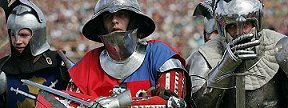

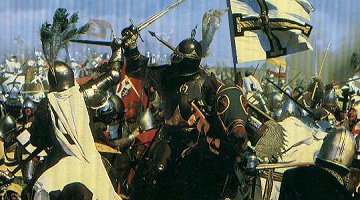
Teutonic knights versus Polish knights.
Photos from reenactments in 2001-2005.

Battle of Towton 1461, by Graham Turner.
[The Battle of Towton in the Wars of the Roses
was the largest and bloodiest ever fought on British soil,
with casualties believed to have been in excess of 20,000 men.]
* If the images don't appear click Refresh button on your screen.
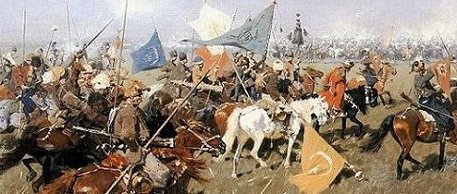
The Cossacks in Wild Steppes, 1660s. Picture by Joseph Brandt.
[Russia, the Ottoman Empire and Poland tried to exploit Cossack warmongering for its own purposes.
Cossacks for their part were mostly happy to plunder everybody more or less equally.]

Battle of Culloden 1746, by David Rowlands.
[Battle of Culloden was the final clash between the French-supported Jacobites,
most of them Highland Scots, and the Hanoverian British Government.
Culloden brought the Jacobite cause - to restore the House of Stuart
to the throne of the Kingdom of Britain - to a decisive defeat.]

Napoleon's return from Russia 1812, by Jerzy Kossak.
[The French invasion of Russia in 1812 was a turning point in the Napoleonic Wars.
The campaign reduced the mighty Napoleonic Grande Armee to a tiny fraction of their initial strength.]

Battle of Solferino 1859.
[Over 215,000 soldiers fought in this important battle. The political context was the struggle to unify Italy.
The French and Sardinian armies defeated Austrian troops. Reports of wounded and dying soldiers being shot
or bayoneted on both sides added to the horror.
This battle would have a long-term effect on the future conduct of military actions. Mr Dunant, who witnessed the battle
in person, was motivated by the horrific suffering of wounded soldiers left on the battlefield to begin a campaign that would
eventually result in the Geneva Conventions and the establishment of the Red Cross and Red Crescent Movements.]

"Missing" - by Frederic Remington.
[The wars between the Sioux Indians and the US Army occurred between 1854 and 1890.
The Sioux were led by famous chiefs and warriors, Little Crow, Crazy Horse, Red Cloud
Sitting Bull, Pawnee Killer and others. The US troops were led by Generals Crook, Custer,
Terry, Miles and others. The most known battles are: Wagon Box, Fetterman, Rosebud, Little Bighorn
and the siege of Fort Phil Kearney.]

Sons of Erin in 1862, by Don Troiani.
[The advance of the Irish Brigade toward Bloody Lane. The slaughter at Bloody Lane became one of the most memorable
and tragic events of the battle of Antietam and the American Civil War. Antietam was was the first major battle in the ACW.]
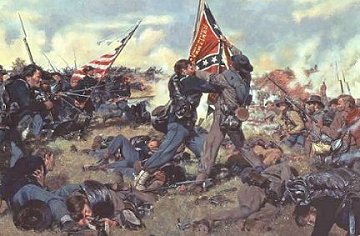
Battle of Gettysburg, by Don Troiani.
[The 6th Wisconsin fight with the 2nd Mississippi for possession of the colors at Gettysburg, 1863.
Gettysburg was the battle with the largest number of casualties in the American Civil War and is frequently cited
as the war's turning point. When the news reached Europe, any lingering hopes of European recognition
of the Confederacy were finally abandoned.]

Tanks of WW 1.
[The stalemate on the Western Front prompted the British Army to begin research into a self-propelled
vehicle which could cross trenches, crush barbed wire, and be impervious to machine-gun fire.
The French developed the Schneider CA1, and first used it on 16 April 1917. German forces initially lacked
countermeasures, though they did discover solid anti-tank shot, and introduced wider trenches to limit the British tanks'
mobility. Germany fielded very few tanks during World War I.]

Tiger Tracks, by Robert Bailey.
[Tiger I is the common name of a German heavy tank. The initial official German designation was Panzerkampfwagen VI.
Tigers were capable of destroying their most common opponents, the American Sherman tank, or British Churchill at ranges
exceeding 1,600 m.
In contrast, the Soviet T-34 equipped with the 76 mm gun could not penetrate the Tiger frontally, but could
achieve a side penetration at 500 m.
The American Sherman's 75 mm gun could not penetrate the Tiger frontally, and needed to be within 500 m to achieve a side penetration.
The great penetrating power of the Tiger's gun meant that it could destroy many of its opponents at ranges at which they could not respond. ]
Excellent article on Tigers, tactics, technology, etc.

The Vietnam War.
[The American War in Vietnam occurred from 1959 to April 1975.]

Hell's Comin' with Me, by Michael Harris.
[US tanks in Iraq.]

Through the Hands of Victory, by David Pentland.
[US troops parade in Baghdad, Iraq.]
** If the images don't appear click Refresh button on your screen.


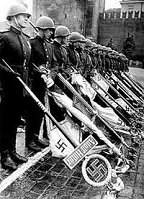 Deposition of captured 1st SS Division Leibstandarte SS Adolf Hitler standards by Soviet soldiers near the Kremlin Wall
during the Victory Parade in 1945. (source: wikipedia.org)
Deposition of captured 1st SS Division Leibstandarte SS Adolf Hitler standards by Soviet soldiers near the Kremlin Wall
during the Victory Parade in 1945. (source: wikipedia.org)

























 On photo: the German "Das Reich SS Panzer Division" is infamous for the massacre of 642 French civilians in Oradour-sur-Glane in 1944.
All the townspeople were assembled near the village centre, ostensibly to have their papers examined.
All the women and children were taken to the church while the village itself was looted by the soldiers. Meanwhile,
the men were led to barns. The soldiers began shooting at them, aiming for their legs so that they would die more slowly.
Once the victims were no longer able to move, the soldiers covered their bodies with kindling and set the barns on fire.
The soldiers then proceeded to the church and put an incendiary device in place there. After it was ignited, the surviving
women and children tried to flee from the doors and windows but were met with machine-gun
fire.
On photo: the German "Das Reich SS Panzer Division" is infamous for the massacre of 642 French civilians in Oradour-sur-Glane in 1944.
All the townspeople were assembled near the village centre, ostensibly to have their papers examined.
All the women and children were taken to the church while the village itself was looted by the soldiers. Meanwhile,
the men were led to barns. The soldiers began shooting at them, aiming for their legs so that they would die more slowly.
Once the victims were no longer able to move, the soldiers covered their bodies with kindling and set the barns on fire.
The soldiers then proceeded to the church and put an incendiary device in place there. After it was ignited, the surviving
women and children tried to flee from the doors and windows but were met with machine-gun
fire.